
Not Straight
The wonderful uneven lines of the old buildings
This year’s WAY AGM was in the land of Shakespeare, at his home town of Stratford-Upon-Avon. So it was a surprisingly small train took us out of the hustle of London and away to a more tranquil town. Stratford really does make an impression. Emerging from the station to be surrounded by obvious regeneration and building sites isn’t necessarily a good one but we were very soon wandering through its mix of modern and wonderfully quirky old. Every corner seemed to hold another opportunity to exclaim “oh, look at that!”

Shakespeare In Shade
The Gower memorial
We walked through the quite small town centre to find our hotel. When booking we hadn’t realised there were no trains out of Stratford on the but luckily we’d booked enough time off work to stay a little longer so first order of business was to find that the fortunately the hotel could accommodate us.

Confused Swan
It kept swimming side to side like a stuck robot!
We left the hotel to take a first look along the river, finding a lovely open space where it is joined by the canal, full of (Shakespeare related) statues and swans. One swan in particular seemed rather confused by a lock, swimming from side to side behind it like a robot who’s programming has reached something unexpected! Hungry we called into the Rose and Crown, which despite being old was a bit of a disappointment on the inside. The food was okay though and refreshed we wandered a little more before getting ready for the evening.

Jettied
An overhanging upper floor
Heather inevitably takes longer to prepare than me (she is a woman!) so I had time to be disappointing by the interior of a couple more pubs, first the Red Lion and then the Pen and Parchment round the corner.
Sadly the WAY trustees had continued their trend of picking an over the top hotel to hold the AGM (and associated official Friday night activities). This year they had overdone themselves with a completely over the top choice which had the major disadvantage of being quite some distance from town. So we got a taxi. There was a buffet, which was annoyingly formal and hardly sausage rolls. There was a comedian, who wasn’t very funny. There was an overpriced bar.

Swans A Swimming
A pretty swan passing by
The AGM proper was on . It was lively, with good debate over how many people should be required for a quorum, and further debate over whether its a good idea to go around cold contacting thousands of people. So lively was the debate that things ran late into the afternoon. There came a point where there wasn’t any interesting business left to discuss though so I left for a further wander around town.
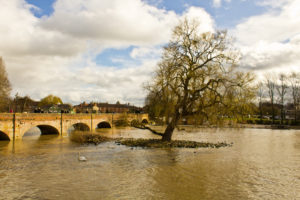
River Scene
The bridge and tree
I found pubs which didn’t disappoint in the form of first the Dirty Duck, where it was very pleasant to sit outside overlooking the river, and later The Windmill, a pub most certainly known to Shakespeare. Heather and Emma eventually showed up from the AGM so we wandered around to the RSC theatres before heading for hotels to get ready for the evening.
The evening dinner was at least better than things earlier in the day or the previous evening, though the food wasn’t as wonderful as they would have liked to think (and I didn’t like my dessert 🙁 ). There was even a brief outburst of decent music from the disco, and a silly photo booth. Bed followed late.

Soothing River View
A look down the Avon
We headed out of the hotel a little before lunchtime for a proper wander around the town. We started back down by the river. On the way Heather found a balloon which became difficult to get rid of. We tried leaving it in a bin but it wouldn’t fit, and in a phonebox which turned out to be a coffee shop, before releasing it to spread happiness through the world (and least on small boy found it). It was hungry work so we went for brunch, Emma joining us in the rather lovely Fourteas Tea Rooms.

Come On Then
Swans waiting for food
Saying goodbye to Emma again we went off via the tourist information to feed some swans, who were quite demanding! Then it was time to get some proper Shakespeare tourism in as we visited his birthplace. It’s quite remarkable to realise that we can walk in the same building in which the country’s most famous playwright was born and raised (indeed, one of the compelling things about Stratford was the number of buildings lurking that may have appeared on a map from the Bard’s time). The birthplace is attached these days to a large modern centre offering an exhibition, which we skipped. The house itself feels as one might expect, and one wonders how recognisable it would be to Shakespeare given the inevitable alterations over time—probably he would still know it though.
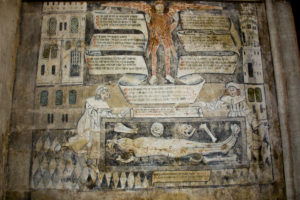
The Dance of Death
The major painting in the guild chapel
We passed on from there to the Old Thatch Tavern for a rest (much smaller feeling on the inside than its exterior experience would suggest). A quick drink later and we resumed our town exploration, with more exclamations of things to look at. We found ourselves in the guild chapel, admiring rediscovered wall paintings that the reformation had caused to be covered over (a task Shakespeare’s father, in his role as Chamberlain of the Corporation of Stratford, had to ensure was done). The chapel is remarkably quite and calm—I wonder how many visitors wander into this important piece of Stratford’s history.

Guild
The guild chapel next to the hall and school, with alms houses the other side
Just around the corner from the guild chapel we found the guild hall. I confess I was a little dubious about going in on arrival but it proved to be one of the more compelling attractions we saw. The ground floor is standard medieval guild hall fair, used for everything from legal hearings to religious gatherings (and probably a party or too. There are some faded wall decorations—a red rose and a white rose, for neutrality, and a very well displayed and interpreted painting where an alter once would have been (the painting is behind a transparent screen which fades in to show a vivid reconstruction in situ). This is also the space in which a young Shakespeare may well have seen travelling acting troops, performing for approval of a licence to act in Stratford.

SChool Room
The old school room above the guild hall, where Shakespeare was taught
Upstairs is even more atmospheric, housing the guild’s school rooms. Here a the boy William was educated, learning much that would influence his later genius. The master’s chair sits silently looking over the long benches, or forms, where the pupils would sit, ranked by age. Wonderfully the schoolrooms are still used by the adjacent King Edward VI School, which grew out of the original guild school, and other local schools.
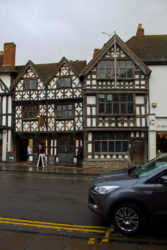
Garrack Inn
Old Stratford pub
Having been educated I introduced Heather to Shakespeare’s local pub as the Windmill is just down the road. We were by now getting hungry and so went in search of dinner. We settled on Carulccio’s. The food seemed okay but unfortunately I think they mildly poisoned me as I certainly didn’t feel right the next morning. Not to know that though we finished the evening off in the wonderfully historic Garrick Inn.
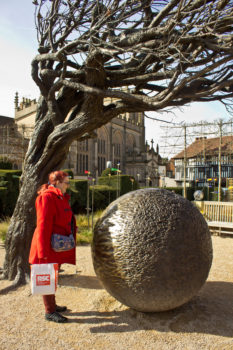
Examining The Brain
Heather tries to make sense of a sculpture
Come Monday morning we were glad the trains had forced an extra day in Stratford upon us. Leaving our bags in the hotel we headed out for some more Shakespeare. There isn’t much left of Shakespeare’s house of later years, and where he died, New Place. The building itself was demolished by a later owner who got sick of people coming to see Shakespeare’s house (presumably this was before anyone thought to charge substantial sums of money to visit). Today all that remains are foundations marked in the ground, the space filled with a variety of sculptures and large gardens. An exhibition is held in the adjoining, still extant, house of Thomas Nash (Shakespeare’s son-in-law) which gives a feel at least of what William’s residence may have been like.

A Doctor's Place
Jars for mysterious medicines and potions
Just around the corner from New Place is the lovely house of Hall’s Croft, home of Shakespeare’s daughter Susanna and her husband, the doctor John Hall. The house has a cosy feel and it is easy to imagine the Halls settled there for the evening, perhaps with Dad William popping round to discuss this latest thing he has written, or take the doctor’s advice on some ailment.

The Grave Of William Shakespeare
Do not disturb his bones
While Shakespeare might have went out to the Windmill, sitting as it does between Hall Croft and New Place, we headed for somewhere with a more picturesque view in the Dirty Duck (AKA The Black Swan), where we relaxed outside for a while, and watched a robin eat a chip. The stroll along the river was then also relaxing, leading us to Holy Trinity Church, the final resting place of Shakespeare. The church is actually quite large, with a really pleasant riverside graveyard which would have made a nice visit even without the playwright connection. The Bard’s grave is the main attraction though, lying before an alter at the end of the church, alongside other members of his family, a poetic engraving on the covering stone compelling all to leave his bones undisturbed.

Timber Framed
More old building
The end of Shakespeare was just about the end of our time in Stratford. We walked back along the river, heading towards the hotel. We were going to find some food but it seemed it not being tourist season most places had stopped serving for the afternoon. Instead we collected bags and headed for a goodbye drink in the White Swan before going to catch a surprisingly direct train (which was even more surprising when it turned out to consist of a whole two coaches). The land of the Bard is compelling though, and may draw us back sometime.
There were, of course, a load more photographs taken.

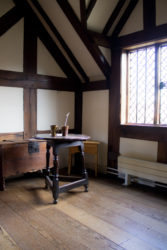
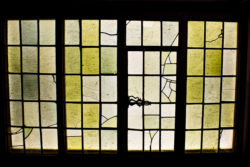
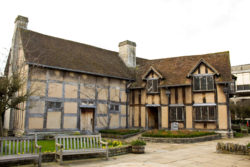

Comments and Pings